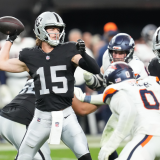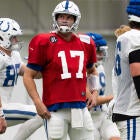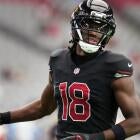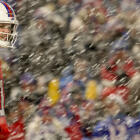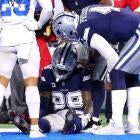Rams vs. Seahawks showdown will be a snapshot into the evolution of the modern NFL offense
Sean McVay and Klint Kubiak have both been the league's finest playcallers this season, going backwards as offense moves forward
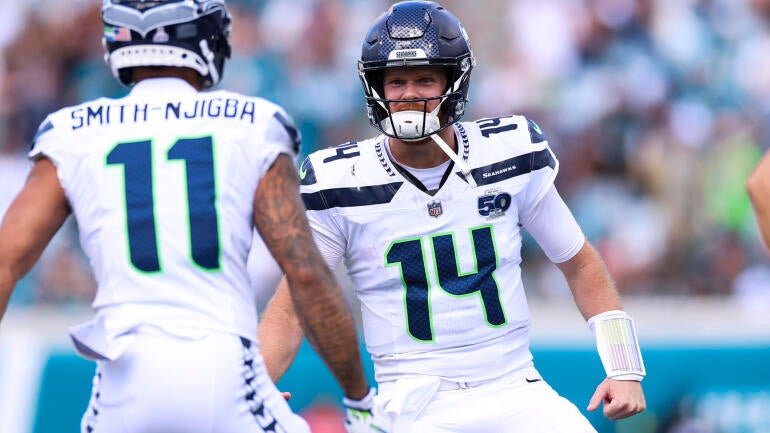
Y'all know the phrase, "There's nothing new under the sun," correct? The idea that there are no new ideas might be a bit of a stretch, but there's something to the idea of repeating history -- both good and bad. The same can be said about modern NFL offenses. The era of big boy football has returned, with tight ends and extra offensive linemen seeing more time in the sunlight than a houseplant in the winter. At the forefront of this offensive evolution are two teams that'll square off on Sunday afternoon: the Seattle Seahawks and Los Angeles Rams.
Two teams will be fighting not only for the right to call themselves the best team in the NFC, but in the entire NFL. Since Week 7, both the Rams and Seahawks have been in the top 10 of overall Success Rate as an offense, with two quarterbacks playing at MVP-caliber levels: Matthew Stafford and Sam Darnold.

But that's not where the rubber meets the road just yet, when it comes to why both of these offenses have blasted opposing defenses lately. Since Week 7, Los Angeles has faced the highest percentage of snaps against base defense (four defensive backs) in the NFL at 51%, and Seattle isn't that far behind at 45.4%. While the goal for both teams is to shred the base defense in the passing game, how they have achieved this is where these two paths diverge.
What the Rams are doing
When star wide receiver Puka Nacua went down with an injury in the Rams' Week 6 win over the Baltimore Ravens, the Rams' entire offense had to change. Not only is Nacua one of the NFL's most impactful receivers in the passing game, but with Nacua on the field, they didn't lose any strength in the run game. He was essentially a tight end in the run game, tasked with clearing out defenders inside the tackle box. The problem with that was that teams could defend them in nickel, defending their run game just as they would any other team in 11 personnel. To keep the Rams on the cutting edge of modern NFL offense, coach Sean McVay would have to change his stripes once again. The Rams have never really majored in anything outside of 11 personnel, but without Nacua and nickel defenses becoming much better suited to defend the Rams' run game, McVay decided to add tight ends on the field to ease some of the issues they were having.
Not only have the Rams eased some of their issues, but they've also become a machine on offense. Since Week 7, the Rams are first in EPA per play and Success Rate, and quarterback Matthew Stafford has been on a tear. I think Tom Brady had the best explanation for why the Rams have shredded teams in base defense lately, via AJ Schulte of A to Z Sports: "The interesting thing about 11 personnel is that there's probably 20-25 different coverage combinations you can face as a QB. When you go to a 3 TE grouping and they play base defense, you're dealing with 3 or 4 combinations. So it simplifies the defensive playbook by about 20%, so many fewer looks for QBs to diagnose post-snap, and allows you as a play-caller to dial up exactly what you want."
What Brady is saying is that when you play a heavier defense with more linebackers on the field, it's a lot harder to scheme around the coverage limitations of a linebacker than to scheme around the run defense limitations of a nickel corner. Against the 49ers, when the Rams were in 13 personnel, the Niners played Cover 3 on 17 of the 31 snaps, which is approximately a 55% clip. When you line up in single high and play Cover 3 as obviously as the Niners did, that's just making the game easier for one of the best QBs in the game right now.
McVay has decided that it's easier to draw up winning passing combos for a tight end like Terrance Ferguson against a linebacker instead of trying to scheme up WRs Jordan Whittington or Konata Mumpfield against a shiftier nickel corner, and the results are paying off in a big way. Ferguson has come on strong in the last three weeks, averaging a strong 3.3 Yards Per Route Run (third in the NFL among TEs). He's their matchup nightmare, capable of doing this to linebackers:
Trying to match this Rams offense with base isn't gonna end well, especially when Terrance Ferguson is on the field. He's their field stretcher, and giving him a free release against a LB is gonna end up like this a lot pic.twitter.com/MrOnrWkAUO
— JP Acosta (@acosta32_jp) November 12, 2025
Or, using Ferguson's long speed to create voids for wide receiver Davante Adams, like on this play here:
The Rams getting to this scissor concept out of 13 personnel with Terrance Ferguson running the clearout corner route for Davante Adams. Look at when Stafford releases this ball lol pic.twitter.com/2KPlrE7oO3
— JP Acosta (@acosta32_jp) November 12, 2025
With bigger-bodied TEs on the field more often now, they can also use these players to unlock more varied parts of their run game. Bigger bodies allow for their offensive linemen to get to the second level, with tight ends being able to base block EDGEs if necessary. Or, you can insert them with more success against linebackers than a smaller player like Whittington would.
LAR starts in 13 personnel with all the TEs to the formation's left. Motion Ferguson to the other side and the Niners balance themselves out, giving this insert block by 87 a lot of room to breathe. Easy 12 yard gain pic.twitter.com/MJiOLix4kn
— JP Acosta (@acosta32_jp) November 12, 2025
McVay has reinvented himself and the Rams offense once again, and it has them sitting pretty near the top of the NFC.
What the Seahawks are doing
Not to be outdone, the Seahawks' offense has been one of the league's most impressive buzzsaws against base personnel, crushing teams using the pass when they get into heavy looks. Quarterback Sam Darnold has a 0.53 EPA per dropback on plays where base defense is on the field, and that explosiveness matches up with how far downfield he's throwing the ball against base defenses. Darnold is averaging an absurd 12.9 yards per pass attempt against base, matching his strong arm and penchant for explosives with slower linebackers on the field.
The Seahawks primarily do this out of 12- and 21-personnel formations, forcing teams to account for their big guys on the field -- despite having a run game that hasn't been particularly explosive or successful on the ground this season. Having these larger personnel groupings on the field has allowed Kubiak and Darnold to create the illusion of a run, thereby moving the linebackers. Then Darnold can take his shots downfield, primarily to wide receiver Jaxon Smith-Njigba. This is very tidy work by Darnold, but watch the linebackers move for Arizona.
Sam Darnold nailing this throw to JSN moving left on a boot. Makes it look easy but that's a pretty tough throw to make! pic.twitter.com/GpsqbFwj5l
— Nate Tice (@Nate_Tice) November 12, 2025
Because of how good the Seahawks are at hitting those over routes off play action, the defense has to make a choice: They can choose to let their linebackers flow fast with the run action and play their safeties hard on the over routes, or they can sit back and slow play the run with their second level. If you choose the first option, that's when Darnold really lets the ball fly. This beautiful touchdown to JSN is a great illustration of that. The Cardinals are sending a blitz, but they also play their linebackers fast. The safety jumps all over this route, but it leaves Smith-Njigba in a 1v1 matchup, which he then proceeds to win. Tough to answer so many questions.
Feels like every ball from Sam Darnold to JSN is a win for the Seahawks
— Anthony (game script enthusiast) (@proant.bsky.social) November 10, 2025 at 5:01 PM
[image or embed]
This leads us to Sunday, a heavyweight fight between two teams that are all about dicing base defense as a passing unit. The question that'll have to be answered on both sides is this: Can you force the other teams' defense into base personnel? The Seahawks play nickel (five DBs) at a 58.3% clip against 13 personnel, by far the most in the NFL (second is the New England Patriots at 35.5%). Seattle hasn't really been tested often by a team that wants to run the ball out of 13 personnel; TruMedia only charts them with nine rushing attempts defended against 13 personnel, but on those runs, Seattle has given up a mere 20% Success Rate.
Seattle plays the least amount of base defense in the NFL, but still has only given up 3.7 yards per carry all season. Where the Seahawks lack in pure size on the field defensively, they make up for it by being absolute banshees defending the run. Mike Macdonald is unafraid of using run blitzes to steal gaps and force offensive linemen to think on the fly as they zone block, having to account for defenders who weren't there. That creates base defense front structures out of lighter personnel box counts, never having to sacrifice coverage bodies against the run. On this play, linebacker Drake Thomas and safety Ty Okada blitz, leaving nobody to account for Pat O'Donnell on the backside, who can clean up the carnage Thomas leaves.
Hey man Drake Thomas is kinda nice with it
— JP Acosta (@acosta32jp.bsky.social) November 12, 2025 at 4:55 PM
[image or embed]
When you watch the Seahawks' defense on Sunday, be aware of linebackers and secondary members who will bring the heat on run downs to change the picture defensively. For the Rams, they play a lot of base defense against 12 and 21 personnel, but something that Greg Olsen said has been stuck in my mind lately about how to attack this Seahawks' offense:
Greg Olsen explains 3-WR run plays and 2-TE pass plays from the best play callers.
— Hayden Winks (@HaydenWinks) November 11, 2025
If he was a DC, he'd match down-distance tendencies rather than match with personnel. https://t.co/jmc6YirJIg pic.twitter.com/FSIP69Uzee
What to expect on Sunday
I wonder if this is the game where the Seahawks see more nickel against their 12- and 21-personnel formations, due to the Rams' size up front. Having Poona Ford, Jared Verse and the L.A. wrecking crew up front should help defend the run game, but leaving their linebackers isolated in coverage might not be the wisest thing to do. Whatever the Rams do, they'll have to ensure they limit explosive passes, because that's how the Seahawks typically attack.
Football is cyclical, with ideas constantly being passed from one generation to the next, and old ideas becoming new again. This game is a perfect example of that -- multiple tight ends, fullbacks, play action and launching the ball downfield. How each defense reacts to this could be the way forward in the NFL as the push and pull for on-field supremacy continues.




